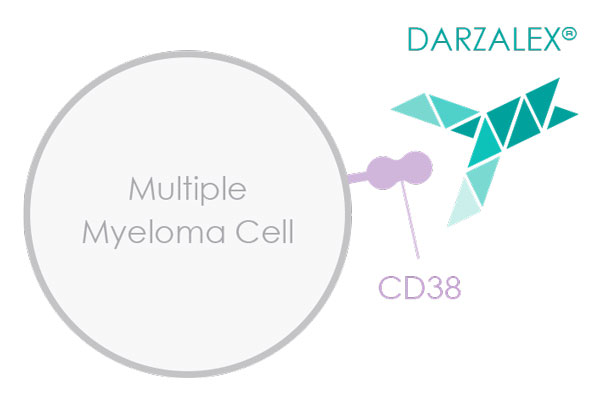
12/09/2016
The Food and Drug Administration (FDA) has approved two new uses for the drug daratumumab (Darzalex®) in patients with multiple myeloma. Daratumumab was originally approved by the FDA in November 2015 as a stand-alone treatment for patients whose cancer has progressed after receiving at least three prior treatment regimens using standard combination therapies. Under the new approval, patients can receive daratumumab in combination with either of two other standard therapies if their disease has progressed after only a single prior treatment regimen.
FDA Approves New Use for Daratumumab in Multiple Myeloma
December 9, 2016 by NCI Staff
The Food and Drug Administration (FDA) has approved two new uses for the drug daratumumab (Darzalex®) in patients with multiple myeloma.
Daratumumab was originally approved by the FDA in November 2015 as a stand-alone treatment for patients whose cancer has progressed after receiving at least three prior treatment regimens using standard combination therapies. Under the new approval, patients can receive daratumumab in combination with either of two other standard therapies if their disease has progressed after only a single prior treatment regimen.
Daratumumab targets a protein, CD38, that is often overexpressed on multiple myeloma cells and also expressed on many types of immune cells. It’s thought to work both by killing tumor cells directly and by stimulating an immune response against cancer cells.
The drug’s new approval is based on two large randomized clinical trials in which patients who received the drug along with one of two standard combination therapies had substantially longer progression-free survival than patients who received only the two standard drugs.
In one of the phase III trials, called POLLUX, patients were assigned to receive daratumumab in combination with lenalidomide (Revlimid®) and dexamethasone or to receive lenalidomide and dexamethasone alone (control group).
According to recently published results from the trial, at 12 months after beginning treatment, approximately 83% of patients in the daratumumab group were alive without their disease progressing, compared with 60% of patients in the control group. And more patients treated with daratumumab had reductions in the size of their tumors or had their disease resolve completely than patients in the control group.
The other phase III trial, called CASTOR, assigned patients to receive a three-drug combination of daratumumab, bortezomib (Velcade®), and dexamethasone or bortezomib and dexamethasone alone. Similar to the POLLUX trial, outcomes were superior for the patients who received daratumumab in addition to standard therapy. At 12 months after beginning treatment, nearly 61% of patients who received daratumumab were alive without their disease progressing, compared with approximately 27% of those in the control group.
The most common side effects in both trials were similar and included infusion reactions, diarrhea, and upper respiratory tract infections.
With the results of these trials and the FDA’s approval, patients will likely start receiving daratumumab earlier, as part of a three-drug combination, in their treatment course, said Dickran Kazandjian, M.D., an FDA/NCI investigator from the Medical Oncology Service in NCI’s Center for Cancer Research.
Both trials “showed impressive efficacy,” Dr. Kazandjian added, and the FDA approval gives clinicians “two more triplet-based regimens” for the treatment of patients whose multiple myeloma has returned after just a single course of treatment or that doesn’t respond to initial treatment.
The availability of daratumumab is “potentially especially important” for older patients with other chronic health conditions and with a poor performance status, he explained, “given that, other than infusion reactions, it is very well tolerated.” But prospective clinical trials are needed to confirm this, Dr. Kazandjian added.
Approvals Bring More Options, New Challenges
This new approval for daratumumab follows more than a decade of substantial progress against multiple myeloma. The overall survival rate for this cancer has doubled since the mid-1970s, due largely to the use of autologous stem cell transplants and, more recently, the introduction of lenalidomide and bortezomib.
And new therapies for multiple myeloma continue to be introduced. Including daratumumab, the FDA has approved six new therapies for this cancer since 2013, often for use in combination with other drugs, a trend that has been heralded by researchers and patients alike.
“The availability of multiple treatment options is welcome news,” wrote S. Vincent Rajkumar, M.D., and Robert A. Kyle, M.D., of the Mayo Clinic in an editorial that accompanied the publication of the POLLUX trial results.
But a broader selection of effective therapies has brought its own challenges, Drs. Rajkumur and Kyle continued—namely, how to decide which therapies are best for which patients or in which sequence different courses of therapies should be given.
“The rapid pace of these advances has left us without clear comparative data for making informed decisions,” they wrote.
Dr. Kazandjian agreed, although he said it’s clear that three-drug regimens that incorporate daratumumab and other new therapies are better than two-drug regimens as an initial treatment and in patients whose cancers have returned.
In the absence of data on the best sequence of treatments, he added, in current clinical practice, oncologists choose the combinations that they perceive to strike the best balance of efficacy and safety.
To help fill this informational void, Dr. Kazandjian concluded, head-to-head clinical trials are needed that directly compare the currently approved three-drug combinations, as well as studies that assess different sequencing of the approved regimens.























.jpg)












No hay comentarios:
Publicar un comentario